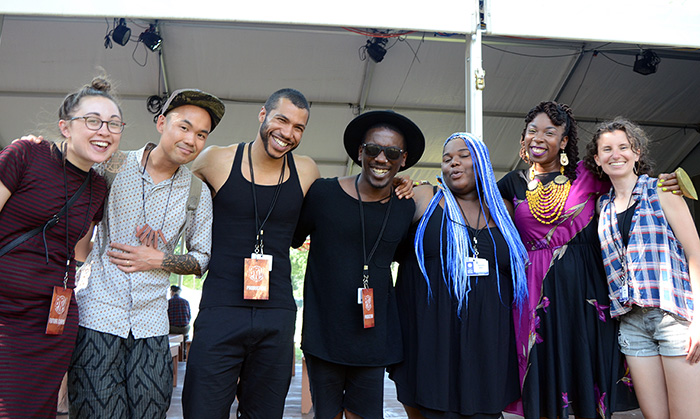Brave New Voices: Listen and Learn

I was in high school when the HBO premiered the series Brave New Voices (2009). I remember being in awe of the force behind the voices of teenagers collectively sharing their stories through spoken word, across the cities spotlighted on the show. I had not seen anything like this before in my Illinois suburb. The show honed in on the challenges the young poets faced dealing with race, politics, and self-image, and, with the help of coaches, learning to sharpen their tongues to cut through barriers. The series captured each moment leading to the final poetry slam competition.
The show inspired me throughout college to actively seek my place in America’s social and political landscape, preserving my thoughts in free verse. But as time passed, the writing stopped. I went on to graduate school, and put down my passion for poetry in exchange for a full course load, assigned weekly readings, and research seminars.
This year, the Folklife Festival allowed me to experience again the feeling that comes from the raw energy of young people. I sat front and center for performances by members of Youth Speaks, an internationally recognized spoken word and arts advocacy group, and the creator of the annual poetry slam festival Brave New Voices.
Founded in 1996 in San Francisco, Youth Speaks promotes literacy and engagement through arts and education with in school and after-school programs. They established Brave New Voices two years later, giving space to thirteen- to nineteen-year-olds in teams from cities around the world to perform spoken word on topics of social and environmental justice, gender equity, and more. Now it represents a network of organizations dedicated to youth education and development. The HBO series followed in the footsteps of producer Russell Simmons’ previous series, Def Poetry Jam, which focused on an older generation of poets and performers.
Tassiana Willis, a Youth Speaks fellow, brought us into the Sounds of California Stage & Plaza with her soulful voice washing over the audience. Her rendition of “Wade in the Water” brought me to tears. Embedded in a poem about love and loss were vivid images of community displacement illustrated by the words of Ebony Donnley. These were their truths, their emotions voiced in ways that many of us learn to suppress as we get older. As they stepped off the stage, I thanked the presenters for sharing what so many of us try to forget or avoid.
This week is the Brave New Voices International Youth Festival, which began July 12 and ends today with the Final Grand Slam. The theme #iTooAmAmerica borrows from the 1945 poem “I, Too, Sing America” by Langston Hughes. Among a crowd of people from Michigan, Texas, and as far as the UK, Youth Speaks brings together the innovation of a cultural art form that, like Hughes’s poem, shifts and shapes with time.
“The points are not the point; poetry is the point”
During the Brave New Voices festival, presenting teams are reminded that they are not there in competition but in conversation, pushing forward a dialogue and proving that each voice matters. Poets approaching the mic are greeted by chants from their teams. I kept waiting for snickering, for little slights toward other teams, but nothing like that happened. As an audience, offering up a holler, a sigh, and a snap are a sign of respect to the speaker, followed by an uproar of cheers. Hugs are free and passed around dutifully.
What I witnessed was a nineteen-year tradition for generations of Brave New Voices alumni, mentors, and coaches who are cultivating affirming spaces for young people, for hope, and for healing. Youth Speaks’ presence at the Folklife Festival was a powerful statement at the core of our mission to celebrate traditions born in community and to allow individuals to speak for themselves. It is a reminder that the stories of tomorrow are being told by today’s younger generation, so we should listen carefully.
Ravon Ruffin is the social media coordinator for the 2016 Folklife Festival. She is a recent graduate from George Washington University, with a master’s in American studies and concentration in museums and material culture. She is the co-creator of Brown Girls Museum Blog.
Audio recorded by the Ralph Rinzler Folklife Archives documentation team.
The 2016 Sounds of California Smithsonian Folklife Festival program was co-produced with the Alliance for California Traditional Arts, Radio Bilingüe, the Smithsonian Asian Pacific American Center, and the Smithsonian Latino Center.

